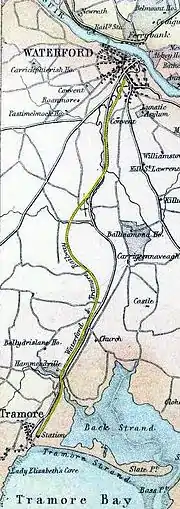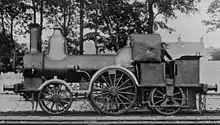Waterford and Tramore Railway
The Waterford and Tramore Railway was a railway in County Waterford, Ireland, that linked the city of Waterford and the seaside town of Tramore, a distance of 7 1⁄4 miles (11.7 km). It was opened on 5 September 1853 and closed on 31 December 1960.

History
Construction began on 10 February 1853. The Waterford business community met the £77,000 cost. William Dargan's construction company completed the single track line in seven months – a considerable achievement as a section of line outside Waterford ran over deep bog covered with bulrushes. Each terminus included a turntable.
On 1 January 1925 the Great Southern Railways (GSR) was formed and absorbed the W&TR. On 31 December 1944 the GSR and Dublin United Transport Company merged to form CIÉ.
The Waterford and Tramore Railway was the only line in Ireland that was not connected to any other. Its terminus in Waterford was in Manor Street. All other railways to Waterford used Waterford railway station situated on the opposite side of the River Suir.
The W&T was one of five railways that served County Waterford. The others were:
- Dublin and South Eastern,
- Waterford and Central Ireland,
- Waterford, Dungarvan and Lismore,
- Waterford, Limerick and Western Railway.
Closure
On 27 September 1960 CIÉ announced that it would close the line on 31 December and replace it with a bus service. To avoid demonstrations, the last scheduled train did not run. The final trains run were the 13:25 from Waterford and the 14:10 from Tramore.
In the first half of 1961 all the tracks were lifted. The rails were scrapped by a Dublin scrap firm and the sleepers were sold for use in defences against coastal erosion.
Locally it was rumoured that the tracks were to be shipped to Nigeria. Similar false rumours attended many railway closures at the time.
One of the few remaining traces of the railway is Tramore station house, which is currently the offices of Tramore Failte.
Motive power

The railway was initially worked with two 2-2-2 tank locomotives built by William Fairbairn & Sons in 1855, numbered 1 and 2. Several other locomotives were added later. No. 2 was scrapped in 1928. No. 1 remained in service until 1936 when it was derailed and plunged down an embankment, and cut up on the site. By then several other locomotives had been brought to the W&T from the main railway network. When No. 1 met with its end, It was then the last locomotive with single driving wheels in regular traffic in the British Isles.[1] From 1955 diesel railcars served the line.
References
- Casserley 1960, p. 18.
Bibliography
- Casserley, HC (1960). Historic locomotive pocket book. London: BT Batsford. p. 18.
- Fayle, H; Newham, AT (1972) [1964]. The Waterford & Tramore Railway. Newton Abbott: David & Charles. ISBN 0-7153-5518-X.
- O'Donoghue, Frank (2012). The 5-Minute Bell. Frank O'Donoghue. ISBN 9780957448407.
External links
- "Waterford & Tramore Railway --: Early History". Edmund Rice Primary School.
- Waterford-Tramore Railway: Road Maintenance Costs
- Closure rumours
- Closure debate